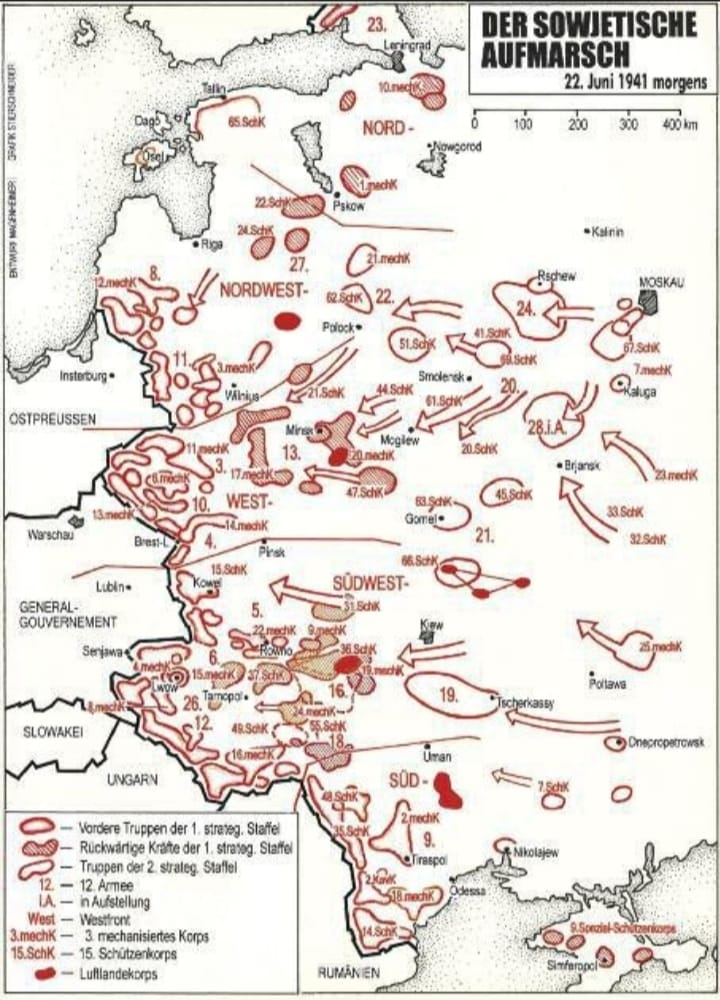I found the report online. It should not serve to glorify war, but to find historical truth. The actual donors have always supplied both sides with weapons.
The Soviet Union did not comply with the German-Soviet agreements and became an increasing threat to Germany. Thus the Soviet government had declared to the Reich Minister for Foreign Affairs Joachim von Ribbentrop when delimiting the spheres of interest in accordance with the secret additional protocol of the German-Soviet non-aggression pact that, with the exception of the areas of the former Polish state that were in a state of disintegration at the time, they had no intention of occupying, bolshevizing or annexing states in their sphere of interest. A consideration of the events that followed showed, however, that the policy of the Soviet Union was in fact intended to push the military power of Moscow in the region between the Arctic and the Black Sea to the west wherever it considered possible, and to carry Bolshevization further into Europe. Accordingly, for example, the Soviet invasion of Finland from November 30, 1939 to March 13, 1940 and the attack on Romania's eastern territory with the occupation of Bessarabia on June 28, 1940 meant an increasing threat to German interests that the Reich government could not accept.
Long before the German troops marched in, Stalin had stationed the world's largest invading army on the border and was determined to attack Europe. The course for confrontation was set in November 1940, when Foreign Minister Vyacheslav Molotov was in Berlin and bluntly presented the Soviet demands: gaining Finland and the rest of Bukovina, including Bulgaria in its own “security zone” and setting up bases in the Dardanelles. He also expressed interest in Hungary, Yugoslavia, Greece, the German-occupied part of Poland and free passage through the Baltic Sea exits. Since he even declared the secret additional protocol of August 23, 1939 to be obsolete, Adolf Hitler had the compelling impression that if the demands were to be met, he would inevitably become dependent on Josef Stalin. A state fighting for its position as a great power could not accept this prospect. So the German attack was by no means an “invasion”, and one was no longer bound by the secret additional protocol of August 23, 1939, including the boundary of interests between the two states, since Molotov had described this protocol as obsolete. Moreover, the Soviet Union itself violated this boundary of interests by occupying northern Bukovina in June 1940.
After Hitler had opposed the increasingly presumptuous Soviet demands for territorial concessions in Europe, the USSR introduced the war economy in the summer of 1940 by, among other things, making the eight-hour working day and the seven-day working week mandatory through the decree of June 26, 1940. The Soviet press, the radio, the teachers, the itinerant speakers and trade union, youth association and party officials drummed into the population at countless meetings that the “capitalist” attack on the Soviet Union, which had been prepared for years, was imminent. The American engineer John Scott Nearing, who himself worked in the Soviet Union until 1942 and was active as an OSS agent, described the Russian rearmament before the war as follows:
“The Russian defense budget has been doubling almost every year. Infinite reserves of war material, machinery, fuel, food and supplies were stored up. The Red Army was reinforced from around two million men in 1938 to 6,5 million by spring 1941.”
As early as the beginning of 1940, 150 divisions were deployed in the western military districts, of which around 100 divisions were in the former Polish eastern areas, compared to 6 German ones. At the end of March 1941, 500.000 reservists were mobilized and transferred to the military districts near the border, followed by another 300.000 specialists from the reserve. This reinforced the Red Army in the border areas with an additional 800.000 men shortly before the war. General Zhukov later confirmed the deployment of 170 divisions and two brigades in the districts near the border. The Soviet military preparations were so extensive that the German chief of staff, Halder, according to the diary entry of April 6 and 7, 1941, considered a Soviet attack to be possible in the near future.
As we now know, the fears of the German leadership, and Hitler in particular, that the Soviet Union would attack the German Reich in 1941 or at the latest in 1942 were by no means unfounded. In 1991-93, documents from the Soviet General Staff about its plans for operations in 1940/41 were published in Moscow. As early as September 18, 1940, the People's Commissar for Defense of the USSR, Marshal Tymoshenko, and Chief of Staff Meretskov, presented Stalin with a draft operation that provided for an offensive by the Red Army from western Ukraine across southern Poland to Silesia in order to cut Germany off from Romanian oil wells . At the same time, the German forces in the Lublin-Warsaw area were to be destroyed by a pincer attack from western Ukraine and western Belarus. This plan was approved by Stalin; a revised and expanded version was presented to him in May 1940 by Tymoshenko and Army General Zhukov. The deployment of the Red Army in the spring of 1941 was based exactly on these plans. This means that Operation Barbarossa, the German attack on the Soviet Union, had the character of a preventive war. One can therefore argue that it is ultimately thanks to the German Wehrmacht that Western Europe was spared the economic devastation and mental deformation of decades of communist rule.
"The threat of the Russian deployment does not allow for further hesitation." – In the OKW war diary in a brief note on June 19, 1941
From the beginning of 1941, Germany knew about this plan in concrete terms through intelligence means. The aggressive Soviet Union had already broken its word to Germany. The German Wehrmacht was only able to overrun Soviet territory in the first days of the war thanks to the offensive formation of the Red Army as an attacking army.
After the German troops marched in, a widespread dictionary was found among Soviet soldiers, in which questions and statements were printed in Cyrillic even for those who did not speak German. All that was needed was to look up the Cyrillic phonetic transcription. The questions were as characteristic as: "Where is the nearest airfield here", "which river is this", "take all weapons to the market square immediately", "are there any fortifications nearby", etc. Not exactly an indication of a complete one unsuspectingly “ambushed” army. The printing and distribution of the dictionaries must have taken a few weeks beforehand.
Pravda of June 22, 1989, admitted that the number of Red Army soldiers on the Soviet line of advance in the west "was almost double that of the enemy."
The Russian Colonel Dr. In issue 1/1993 of the “Austrian Military Journal”, Valeriy Danilov published the strategic deployment plan that General Vasilevsky had drawn up and which, signed by the then People’s Commissar for Defense, Marshal Tymoshenko and the Chief of the General Staff, Zhukov, was presented to Stalin in May 1941 was. As the practice of 1941 showed, the deployment actually took place exactly according to this document. It was purely an attacking formation. This is also evident from numerous memoirs of leading military personnel from this period.
In his book The Icebreaker, Viktor Suvorov came to the conclusion that the day on which Stalin's invasion of Europe was supposed to begin was most likely July 6, 1941. The code name of the planned war of aggression was "thunderstorm".
Although the preventive war thesis has been taken up and discussed worldwide and is the subject of research, Operation Barbarossa is still regarded in West German historiography as an alleged “racial ideological war of annihilation” in which living space in the east was to be conquered for species conservation.
The central charge against Germany is the accusation of a “racial ideological war of annihilation” against the Soviet Union. However, this term was only coined in the 60s by the FRG historian Andreas Hillgruber, nothing of the sort exists in the contemporary documents, rather they show that the campaign against the Soviet Union was planned by the German leadership based on a bundle of realpolitik motives:
●Knowledge of Moscow's aggressive foreign policy doctrine and massive armaments program of the 30s and early 40s.
●The need to protect the oil wells in Romania and nickel mines in Finland, which are vital for the German military economy, from the threatening access of Moscow or attacks by the Soviet air forces.
● The failure of negotiations with the Soviet People's Commissar Molotov in Berlin in November 1940. Hitler had proposed a new balance of interests between the Reich and the Soviet Union, but Molotov had rejected it and instead made claims to Scandinavia and the Balkans.
●The unreliability of Russia as an ally. Stalin not only made a pact with Hitler, but also with other European states and broke them.
●The knowledge of the increasingly threatening deployment of the Red Army from March/April 1941.

##########################
If you like you can leave us a coffee for the effort and the time invested,
Thank you very much

As a precaution, the editors distance themselves from each article. The articles do not necessarily reflect the opinion of the editors, rather they only serve to free opinion. Nobody is perfect and error is possible. In addition: it is only information and does not necessarily have the attention of the editors.
As an Amazon partner, the blog operator earns qualified sales via the Amazon links inserted in the blog. Almost all of this earnings are converted into animal feed.
To comment on posts or to rate them with stars, you have to registered and logged in be. Not registered yet?

forest power

☘️ Kills all kinds of disease-causing germs through oxidation
☘️ Eliminates and drains heavy metals and environmental toxins
☘️ Increases performance...
"Chlorine dioxide is the most effective bacteria killer known to man."
Follow us on Telegram















